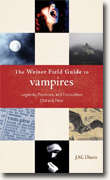The Weiser Field Guide to Vampires
J.M. Dixon
book reviews:
· general fiction
· chick lit/romance
· sci-fi/fantasy
· graphic novels
· nonfiction
· audio books
· author interviews
· children's books @
curledupkids.com
· DVD reviews @
curledupdvd.com
newsletter
win books
buy online
links
home
for authors
& publishers
for reviewers

 |
The Weiser Field Guide to Vampires: Legends, Practices, and Encounters Old and New J.M. Dixon Weiser Books Paperback 192 pages October 2009 |
|
Vampires have been a part of the world’s folklore and legends for centuries, if not longer. They’re surging in popularity now more than ever, as the subjects of bestselling series by authors such as Stephanie Meyers and the love story of Edward and Stella in Twilight. HBO runs the series True Blood, and episodes of the high school cheerleader-turned-vampire hunter Buffy the Vampire Slayer can be seen in syndicated reruns. But is there any basis in reality behind these stories, books, movies, and legends? Do people who claim to be vampires still walk among us? How can you tell if you might be a vampire? Author J.M. Dixon, himself a modern-day vampire, investigates these questions and more in The Weiser Field Guide to Vampires
The King James version of the book says that “these were the great ones of old, men of renown.” But Genesis 6 also seems to suggest that these were not good and kind people, but predators of humanity. The book suggests that their every thought was evil, and chapter 13 of the book of Numbers suggests that wherever these people - the Nephilim - lived, humans were devoured.He also goes into the Celtic legend of the Sidhes of Ireland, “Sidhe being the Celtic word for what today are called vampires.” They fought a war with the Tuatha De Danaan, “a race of powerful human magickal practitioners and warriors” who placed four curses upon the Sidhes, two of which seemed to stick, as they have become over the years associated with vampires: “one that would cause the light of day to scorch their skin and burn their eyes, and one that would allow no water to quench their thirst.”Among other topics related to the nature of vampires and their feeding habits, there’s chapter 3, “Basics of Vampire Feeding”; chapter 4, “Psychic Feeding”; and chapter 5, “Blood Feeding.” According to chapter 3, vampires use “feeding tendrils” to consume the life energies of people: These tendrils, which are made of the same electromagnetic energies that all spirits are made of, have evolved primarily for the purpose of feeding from other spirits. They are denser and more refined than the more basic energies of human spirits, not unlike how a bodybuilder’s muscles are denser and more developed than the average person’s. Given their adaptability and elasticity, the tendrils allow vampires to feed from spirits not in their immediate proximity.Whatever your beliefs about vampires might be, books such as The Weiser Field Guide to Vampires There’s the drawback that if you are squeamish about the sight of blood, being a vampire might not be something that would interest you. Also, if the idea of taking a human being’s life, as some vampires are portrayed as doing, is against your code of morality - or, enslaving them to serve as your feeding vessels is, as well - then, ditto, being a vampire may not be for you. Most people who love reading about vampires and watching movies about them, though, just want to get an adrenaline rush of terror from the experience, or to increase their knowledge of vampires. If you are one of these sorts of people, you’ll want to add The Weiser Field Guide to Vampires Originally published on Curled Up With A Good Book at www.curledup.com. © Douglas R. Cobb, 2009 |
|
|
|
 Click here to learn more about this month's sponsor! |
|
| fiction · sf/f · comic books · nonfiction · audio newsletter · free book contest · buy books online review index · links · · authors & publishers reviewers |
|
| site by ELBO Computing Resources, Inc. | |
 Of course, you have to take the book for what it is - an account of vampires mentioned throughout history, in literature, and in reality - rather than approach it from the mind-set of a scoffer who might be inclined to point out the superstitious nature of many people in the past and even today who are often more inclined to believe in the existence of vampires as an explanation for strange things they encounter instead of a perhaps more scientific and logical reason. That’s just what the author does, mentioning the similarities between the beings called the Nephlims in the Bible, for instance, with vampires:
Of course, you have to take the book for what it is - an account of vampires mentioned throughout history, in literature, and in reality - rather than approach it from the mind-set of a scoffer who might be inclined to point out the superstitious nature of many people in the past and even today who are often more inclined to believe in the existence of vampires as an explanation for strange things they encounter instead of a perhaps more scientific and logical reason. That’s just what the author does, mentioning the similarities between the beings called the Nephlims in the Bible, for instance, with vampires: